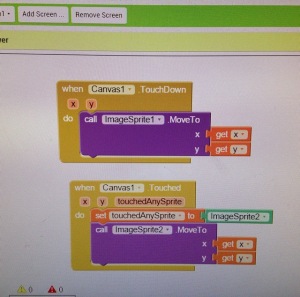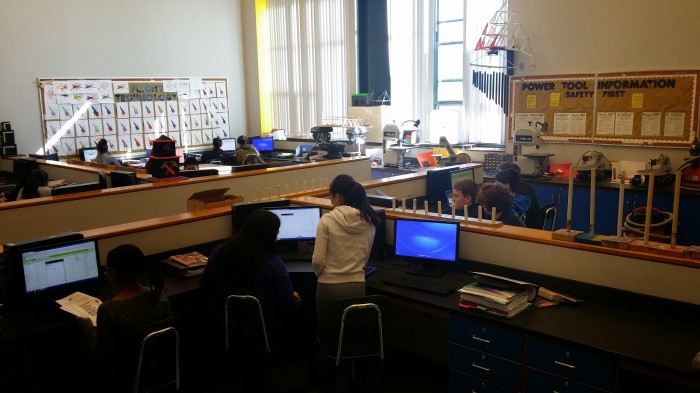Azita, at Andrews Middle School in Medford, is nearing the end of her Middle School Pathways curriculum. Students yesterday did their usual free-typing exercise for the first five minutes of class, then they either continued with a tutorial of their choice (one with a similar functionality to their own intended app) or, just jumped into programming their app itself. Azita typically projects the day’s agenda onto the whiteboard:
Her students – using the pair programming approach – are at varying stages of producing their final apps. One team is working on a game where the user can help elderly people cross the street. Here is their app layout so far:
And here is the beginning of their code:
Another is working on an extension of the Digital Doodle app, where you can import a picture of your friend’s face, trace over it, and then remove the picture to reveal a Picasso-esque drawing. It’s like a drawing-helper app. Maybe we will see some similar things come out of Debbie’s art/technology classes over at McGlynn Middle School.
Another team found an image from an amusing potato meme online, and used it to test out loading pictures into components. This evolved into an idea for a fitness app, where the user’s avatar begins as a “couch potato” and turns into a stalk of asparagus once they finish their workout.
The user will click a button, which triggers a text-to-speech function that gives an instruction to start walking. Then it sets a timer to count down the seconds, and ultimately change the potato image into an asparagus image.
“Okay, to de-potato-fye yourself please start walking at a moderate pace for 10 minutes.”
The pair can’t stop giggling! While they are having fun with the sometimes unexpected path of their creative process, their main focus is getting the timer function to work. Here is their code so far:
The MSP curriculum with Azita’s class has certainly flown by! Other students are excited to incorporate the tablets’ GPS functionality into their apps. Stay tuned – more to come.
























